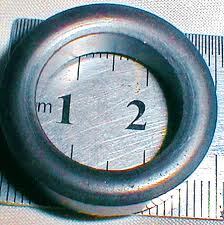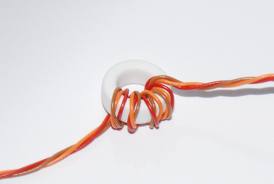
A quick note to clarify the need for and use of ferrite rings…
The ferrite ring acts as a common-mode, inductive filter of the high-frequency noise produced by the switching of the MOSFET’s inside of the ESC. Basically, it prevents the AC current fluctuations inherent in MOSFET switching from progressing beyond the ring itself (it actually looks like a big resistor to high-frequency currents and doesn’t affect DC signals at all), thus eliminating the potential for making your ESC signal wire an antenna that radiates at the frequency of the common-mode noise. It also prevents that noise from getting into your receiver or servo signal wires.
Wait a minute…that first paragraph was filled with a lot of crazy science words, so what the hell does all that mean?! You can think of your ESC as a big valve that supplies electrical current to your motor. If you want 100% throttle, then the valve stays open 100% of the time. If you only want 50% throttle, then the valve opens and closes so that 50% of the time, it’s open and the other 50% of the time it’s closed.
Just like the valve that you have on your kitchen sink, when you open and close it quickly enough, you sometimes hear a banging sound coming from the pipes in your wall. This is the “switching noise” (water hammer in the case of real plumbing) that the ESC produces when the MOSFET’s (switches…or valves in the plumbing analogy) switch on and off.
Because of how fast the switching is taking place inside the ESC, there are frequencies that can be close to that of our radio systems and this is what we want to avoid. Actually, the lower-frequency bands that were used in older radio systems were much more susceptible to this noise than our 2.4GHz systems are. That having been said, it’s not a bad idea to keep the ring in place when an ESC company provides it. It will never hurt the system, only help or do nothing…
Now, let’s say you’d like to add a ferrite ring to one of your ESC’s…this one is quite easy to do, actually. First, you’ve got to get one, right? I like to get mine at an online electronics store called DigiKey. I usually go for the EPCOS 16mm rings, as they give you enough room to fit the BEC lead through the core a few times. These things are super cheap and can be bought in bulk, if needed. If you don’t want to buy online, then you may get lucky and find something similar at your local Radio Shack or other electronics store. Once you’ve got your ring, you want to wrap your ESC’s BEC wire around it as many times as you can without putting undue stress on the wires or insulation. Usually, this is somewhere between 3-5 for the standard servo lead…make sure that you place the ring as close to where the wires exit the ESC as possible to stop the noise from getting any further than necessary. You’re all set!

Let’s take a quick look at the typical ESC manufacturers out there and how they employ ferrite rings… In the case of the Kontronik, it is still capable of noise production on the signal wire because it is not optically isolated like a lot of other high voltage ESC’s. Optical (“opto-isolated”) isolation prevents noise from being transmitted, but also prevents power from being transmitted too…thus, no “opto-isolated” ESC’s have BEC’s in them. Scorpion and Castle HV ESC’s are optically-isolated and as such either don’t come with ferrite rings (Scorpion) or, if they do (some Castles), are simply taking advantage of universal parts in their various product lines rather than having different wires for each ESC.
Hopefully this helps dispel the “hand-waving” and “magic” quite frequently surrounding ferrite rings and gives you one more tool for fine-tuning your rig!
– Justin
